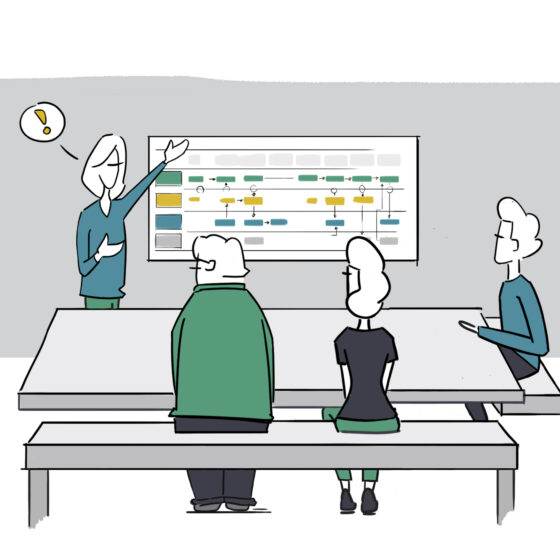First things first: if you want to get started with service blueprints, always do so from a clear goal. Think of improving the customer experience, efficiency gains or breaking through internal silos. A service blueprint is not a goal in itself, but a pragmatic tool to achieve your goal. The service blueprint is also very effective, because you mainly look at your own design to determine the feasibility of your plans.
Download our free service blueprint template guide!
1: the service blueprint is a deepening of the customer journey map
“But we have already mapped out a customer journey.” True, and that is very nice, but with a customer journey map you only have insight into the customer experience. So you know exactly what an end user does, thinks and feels in the context of your service, but you do not yet have a good insight into how that experience came about. The customer journey map does not show which buttons you have to turn to influence that experience. The service blueprint does provide that insight. It is an extension of the customer journey map that shows the services and underlying processes, reasoned from the customer journey. With that knowledge you can implement process optimizations internally, or even design completely new processes. Already more interested in working with service blueprints? Then go straight to the ‘Aligning teams with a service blueprint’ training that we offer from Essense Academy.
2: improved alignment between teams
In many organizations, each department or team is responsible for a part of the customer journey, a certain touchpoint or a channel. However, a customer is not interested in who is responsible for what within an organization; the customer just wants to go through his journey smoothly. To achieve that, teams must work together and understand what the entire customer journey looks like and what their contribution is. Dependencies and overlap come to light in this way. The teams can then better coordinate who does what, when and how, and set priorities. Especially for complex services that affect multiple customer channels, a service blueprint is a welcome tool to bring teams closer together and to keep an overview of all improvement initiatives. This way you retain the omnichannel experience in the realization phase.

3: the service blueprint strengthens the customer perspective
Of course there is a lot of knowledge about the customer internally. However, that knowledge is limited. After all, everyone approaches things from his or her point of view and bases himself on a handful of isolated events. It is difficult to oversee the whole for every team, let alone every individual.
There is a lot of valuable knowledge in-house, add more context with the service blueprint, make it transparent for everyone and then you have gold in your hands.
4: ‘customer logic’ connects internal processes on the service blueprint
For customers, all the interactions they have with an organization form a whole. They have no interest in internal processes and silos. They expect all processes and contact moments to be connected. Example: a customer is logged into his account on the website, but still has to enter his name in the contact form. Very logical from an internal perspective, but incomprehensible to the customer.
Customers don’t care about internal processes and silos.
5: all customer interactions, no more blind spots!
Blind spots and black boxes, with a service blueprint you clear them out of the way. You get all customer interactions on the table with it. Most interactions are part of a channel or sub-process and are therefore the responsibility of a team. And, precisely those interactions for which no one is really responsible, become (painfully?) visible. All bottlenecks come to light, so that you get to the core of the problem.
The service blueprint provides very accurate insight into who has (or should have) contact with the customer and through which channel. This allows you to ensure that the customer experience is consistent everywhere and at all times. For example, you want a customer to receive the same information when he or she calls, visits the website or opens the app. You can only ensure that if you know exactly which customer interactions there are and what the information needs are.
6: quickly identify optimizations with the service blueprint
If all blind spots, black boxes and bottlenecks are clear, you can intervene quickly and implement improvements. Those don’t even have to be grand and immersive optimizations. It can be as simple as writing good micro-copy for fields in a form and implementing that consistently throughout the customer journey across all channels.
7: The service blueprint makes the future specific
You can draw up a service blueprint for the as-is situation (where are we now), but also for the to-be situation. Where do you want to go in the future? What is the vision? Visualizing this creates a shared understanding of the vision and you’re all talking about the same thing. When you have a shared view of what something should look like, you can reason back and determine what is needed “at the back” to make that situation happen. In fact, you translate the vision into concrete activities that you can plan and carry out with the teams required for this. The service blueprint as a crystal ball!
8: The service blueprint feeds the business case
The service blueprint is good input when creating a business model and the business case. They highlight the same aspects, but you do that with the service blueprint from a scenario and the Business Model Canvas is more of a summary.
The Business Model Canvas customer profiles correspond to the top row of the service blueprint, the value proposition is the front stage and the resources are the backstage or supporting processes. The other columns in the Business Model Canvas are the lines of interaction of the service blueprint. So why a service blueprint is useful for your business case? You make clear what you do, how you do it and what you need. This gives the business case much more context and weight. Add what (you expect) it will yield and effort, and you have the parameters for your business case.
Download Service Blueprint
Please add your details below and we’ll mail you our service blueprint template guide with tips and instructions.









